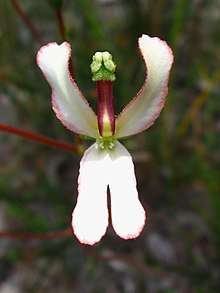Stylidium schoenoides
Stylidium schoenoides is a species of dicotyledon plant from Stylidium genus, from Stylidiaceae family, Asterales order, first described by Augustin Pyramus de Candolle in 1839.[3][2] The plant is endemic to Western Australia.[1]
| Stylidium schoenoides | |
|---|---|
 | |
| Scientific classification | |
| Kingdom: | Plantae |
| Clade: | Tracheophytes |
| Clade: | Angiosperms |
| Clade: | Eudicots |
| Clade: | Asterids |
| Order: | Asterales |
| Family: | Stylidiaceae |
| Genus: | Stylidium |
| Species: | S. schoenoides |
| Binomial name | |
| Stylidium schoenoides | |
Description
Stylidium schoenoides is a perennial herb growing to a height from .15 to 0.5 m high. The leaves form a rosette and are 14-35 cm by 1-1.8 mm and hairless, though there are membraneous scale leaves present at base of mature leaves. The flower stalk has glandular hairs and long soft weak hairs. The white-cream flowers may be seen from August to November.[1]
Habitat
It grows on sand, sandy loam, and granite, on hillslopes, dunes, and plains, in forests, heaths, woodland and shrublands.[1]
gollark: Perhaps I should obtain that game.
gollark: ++delete hypixel
gollark: ++list_deleted
gollark: No idea about that one.
gollark: No.
References
- Western Australian Herbarium, Biodiversity and Conservation Science. "FloraBase—the Western Australian Flora". florabase.dpaw.wa.gov.au. Retrieved 2020-03-01.
- Candolle, A.P. de (1839). Candolle, A.P. de (ed.). "Stylideae". Prodromus Systematis Naturalis Regni Vegetabilis. 7 (2): 782.
- Roskov Y., Kunze T., Orrell T., Abucay L., Paglinawan L., Culham A., Bailly N., Kirk P., Bourgoin T., Baillargeon G., Decock W., De Wever A., Didžiulis V. (ed) (2014). "Species 2000 & ITIS Catalogue of Life: 2014 Annual Checklist". Species 2000: Reading, UK. Retrieved 26 May 2014.CS1 maint: multiple names: authors list (link) CS1 maint: extra text: authors list (link)
| Wikimedia Commons has media related to Stylidium schoenoides. |
This article is issued from Wikipedia. The text is licensed under Creative Commons - Attribution - Sharealike. Additional terms may apply for the media files.